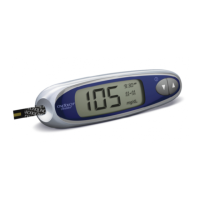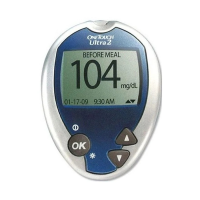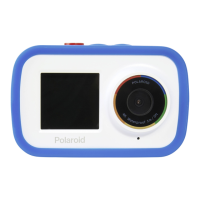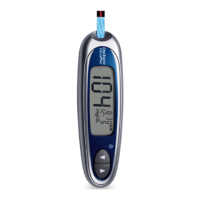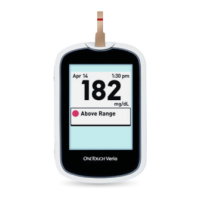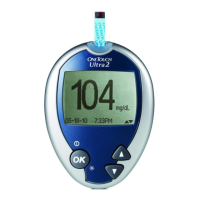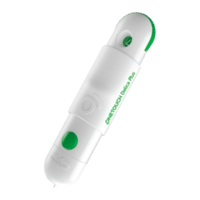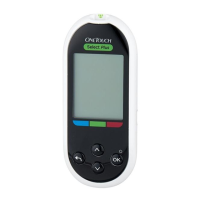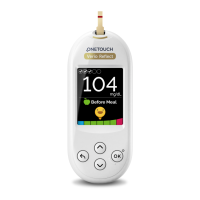Do you have a question about the OneTouch ULTRA2 and is the answer not in the manual?
Purpose and scope of the blood glucose monitoring system.
Explanation of how the meter measures blood glucose levels.
Lists items provided in the OneTouch® Ultra® 2 Blood Glucose Monitoring System kit.
Lists items that can be purchased separately for the system.
Details the display, buttons, and test port of the meter.
Describes the edge for sample application and confirmation window.
Instructions for turning the meter on, off, and managing backlight.
Steps to set the meter's language and date format for first-time use.
Procedure for setting the correct date and time on the meter.
Reviewing and saving the meter's configuration settings.
Instructions to turn the feature for adding notes to results on or off.
Procedure for checking the test strip vial code before the first test.
Steps for inserting a test strip and ensuring meter-code match.
Gathering necessary supplies and notes for blood glucose testing.
Detailed steps for obtaining a blood sample using the lancing device.
Steps to insert the test strip and lance the finger for sample collection.
Techniques for getting a suitable blood drop for testing.
Procedure for applying the blood sample to the test strip.
Ensuring the confirmation window is filled and waiting for the result.
How to read the glucose result and actions after obtaining it.
Instructions for safely removing and disposing of used lancets and test strips.
Guidance on understanding low, high, and other unusual glucose readings.
Introduction to testing with forearm or palm samples and related cautions.
Steps for preparing to get a blood sample from forearm or palm.
Procedure for lancing and applying blood from alternate sites.
How to flag results as before or after a meal for better analysis.
Procedure for selecting and adding descriptive comments to test results.
Navigating the meter to see stored test results and calculated averages.
Steps for transferring meter data to a computer using software.
Situations requiring the use of control solution to verify meter accuracy.
Step-by-step guide for performing a control solution test.
How to apply control solution and interpret the meter's reading.
Comparing the control result against the range on the test strip vial.
Instructions for replacing the meter's primary and backlight batteries.
Guidelines for proper storage and cleaning of the meter and accessories.
Interpreting warning messages like LOW GLUCOSE, HIGH GLUCOSE, and TEMPERATURE ERROR.
Interpreting error messages like ERROR 1 through ERROR 5 and LOW BATTERY.
Addressing messages related to memory or inability to recall results.
Understanding differences between meter readings and lab tests.
Details on meter performance, size, weight, and operating ranges.
Information on compliance with various electrical and safety certifications.
| meter power source | One replaceable 3.0 Volt CR 2032 lithium battery |
|---|---|
| backlight power source | One replaceable 3.0 Volt CR 2032 lithium battery |
| battery ratings | 2 x 3.0 V d.c., 60 mA |
| temperature range | 6–44°C |
|---|---|
| relative humidity range | 10–90% |
| altitude range | up to 3048 metres |
| weight | 42.5 grams |
|---|---|
| size | 7.92 x 5.72 x 2.29 cm |
